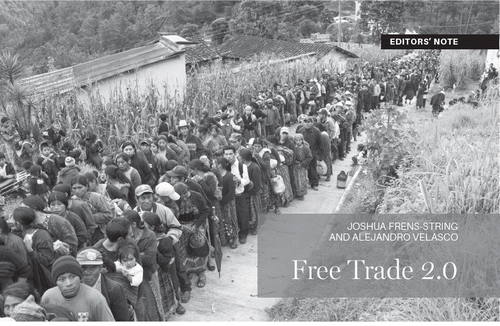Locals from the community of Xesaná line up on October 26, 2014, to vote in a community consultation on extractive and energy industries in Santa Maria Chiquimula, Guatemala. JAMES RODRÍGUEZ.

The year is 2005. Latin America’s “pink tide” is at its crest. In Mar del Plata, Argentina, heads of state are assembled at the Fourth Summit of the Americas and the U.S. seeks regional backing for its plan to create a “Free Trade Area of the Americas” (FTAA)—a project that would extend many of the provisions of the 1994 North American Free Trade Agreement (NAFTA) across the hemisphere. But what should be another feather in neoliberalism’s cap proves instead to be one of the most significant victories for the alter-globalization/global justice movement when left-wing governments and social movements from around the Americas successfully block the FTAA. “In the future,” said the late Venezuelan president Hugo Chávez of the historic moment, “we will speak of U.S.-Latin American relations in terms of the era before Mar del Plata, and the era after it.”
In important ways Chávez’s words continue to resonate over a decade later. The wave of progressive governments that took office around Latin America in the early 2000s allowed the region to consolidate unprecedented economic autonomy vis-a-vis the United States while also experimenting with new forms of regional economic integration. Yet, by 2016, the political landscape has shifted. Right-leaning governments have retaken state power around much of the region (the subject of our Winter 2016 issue of the Report on the Americas). Debates about free trade policy, past and present, dominate the U.S. presidential race. The social and economic consequences of NAFTA and CAFTA-DR (the Dominican Republic and Central American Free Trade Agreement) remain visible, and even the FTAA’s ashes still smolder.
Our latest Report examines Latin America during a moment of resurgent economic empire, once more driven by the U.S.’s desire to extend the reach of free trade and investment. To be sure, the picture is gloomy. Alejandro Álvarez and Manuel Pérez-Rocha find disturbing parallels between the laws and logics of free trade developed in the 1990s and early 2000s—from NAFTA to CAFTA and beyond—and the provisions written into the TransPacific Partnership (TPP), the unprecedented mega-trade treaty that is currently up for ratification in the U.S. and several Latin American and Pacific Rim countries. On Colombia, Forrest Hylton and Aaron Tauss consider how peace negotiations with the FARC will serve the interests of capital, while Sarah Stephens, among the most tireless campaigners against the U.S. embargo on Cuba, breaks down what role U.S. commercial interests have played— and will likely continue to play— as economic reforms continue on the island.
As the region’s political landscape shifts, so does its economic geography. Kevin P. Gallagher, author of a new book on China’s economic influence in Latin America, lays out just how much Chinese investors have seen their power across the region grow over the last 20 years. As a result, ecological and economic imperatives have come into conflict with one another, an issue that Nicole Fabricant and Bret Gustafson and Diana Coryat and Manuela Lavinas Picq examine in their respective pieces on the deepening of extractive economies in Bolivia and Ecuador. And while much has been written about the “boom and bust” cycles driving the region’s economic conditions, David Rosnick provides an alternative take on what may underlie the region’s present malaise.
And yet, important challenges to the current state of things aren’t just possible; they’re happening. In this issue’s photo essay, photojournalist James Rodríguez provides a unique, on-the-ground portrait of the campesino and indigenous social movements that are on the front lines of resistance against the transnational mining companies that have become perhaps the most recognizable face of international capital in Guatemala. Former Bolivian ambassador to the U.N., Pablo Solón, provides a crucial recap of the civil society resistance that helped halt the FTAA in the early 2000s, reminding us that regardless of context, no victory comes without organization and struggle—or without leaving its impact near and far. Indeed, though the situation in Latin America seems bleak, a grassroots struggle to block the Transatlantic Trade and Investment Partnership (TTIP), a free trade deal that would link markets in the European Union and the United States, is raging in Europe and resembles Latin America’s fight against the FTAA just one decade ago. Victories are indeed possible, and resonate.
Beyond trade and economic empire, in our feature essay political scientist Anna Sampaio details how political and demographic shifts have transformed Latin@ communities into a powerful electoral force ahead of the 2016 election. In our Around the Region section, Joaquín M. Chávez offers a timely analysis of El Salvador 25 years after U.N.-backed accords brought that country’s civil war to an end. Suyapa G. Portillo Villeda provides a panoramic view of the state of social movement organizing in Honduras since the 2009 coup. And Alexandre Fortes narrates how Brazil’s Right coopted popular discontent to launch a parliamentary coup against the government of Dilma Rousseff.
Fig 2 Protestors at the March for Clean Energy in Philadelphia oppose the ratification of the Trans-Pacific Partnership in July 2016. PAUL BECKER / CREATIVE COMMONS

In our Archives section, Historian Alan McPherson revisits one of the defining moments of the inter-American Cold War—the 1976 assassination of Chilean diplomat Orlando Letelier in Washington, D.C. And in Arts & Reviews, we feature the work of Uruguayan poet Virginia Lucas, and reviews of Devyn Spence Benson’s new book on race and anti-racism in post-revolutionary Cuba and Julie Weise’s study of Mexicans in the U.S. South.
Don’t miss any of our analysis in the revamped NACLA Report on the Americas. Subscribe today at: http://www.tandfonline.com/pricing/journal/rnac20
